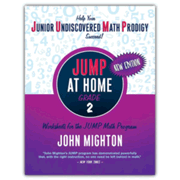The situation with JUMP at Home Math is a bit complicated. There’s a JUMP Math Program that is designed for the classroom with teacher materials and other ancillaries. JUMP at Home workbooks are actually worksheets designed to be used as part of the complete JUMP Math Program—the front covers of the books say, Worksheets for the JUMP Math Program. After looking at books for grades one and two, I think that these workbooks by themselves might serve as the core of your math program, but not for everyone.
First, I’ll explain the JUMP Math approach. JUMP Math is a very visual and conceptual program. I’m fairly certain that in a classroom teachers would be using manipulatives as they teach new concepts. While the workbooks don’t require the use of manipulatives, it would be very easy to incorporate them. Base Ten Blocks seem to be a core manipulative, but you might also Cuisenaire Rods, dominoes, Judy clock faces, and other manipulatives. At the beginning of each workbook are many suggestions for hands-on and interactive math learning activities and games plus worksheet pages for supplemental activities. The program teaches one concept at a time, teaching in increments so that students master both concepts and skills. Each concept is taught a number of different ways to ensure that students understand. Workbooks, although printed in black and white, are heavily illustrated so that students can see visual representations as they learn abstract mathematical concepts.
Workbooks are divided into sections in an unusual fashion. The units (in the first two books that I had for review) are arranged in the following order: Number Sense 1, Patterns and Algebra 1, Measurement 1, Probability and Data Management 1, Number Sense 2, Patterns and Algebra 2, and Measurement 2. The Number Sense units comprise the bulk of each book at these levels since this is where students are learning basic math. Other units cover most of the other topics generally taught to meet the Common Core Standards in the U.S. (Geometry is missing which is fairly irrelevant in the early grades, and subtraction moves a little slower than in the Standards.) JUMP Math is a Canadian program, so money lessons deal with Canadian money rather than U.S., and you might spot the occasional British spelling such as "colour."
You have to figure out when to use the learning ideas at the front of the book. There are some great ideas there, so you should try to schedule them in purposely so they are not forgotten.
There are no teaching instructions for each lesson, but free answer keys are available online. (To access it, one does have to log in, but there is no cost involved. Be sure that you select the JUMP at Home answer keys.) While parents can easily check answers for the first two books without reference to answer keys, after that you will almost certainly want them to save time. At this same website, you will find teaching instructions and tests that apply to the complete program. Some of this might be useful to you since the content covered is similar.
For almost all lessons, it is obvious from the directions or problems what students are supposed to do, although young students will probably need frequent explanations from parents or teachers. Lesson presentations continually change format, so students often need to learn how to complete a new type of exercise while also learning a new concept. Some activities might be done independently but most young students should be working fairly closely with a parent or teacher through these lessons. That means JUMP at Home Math for the early grades might not be the best choice for parents who do not have the time to work closely with their children. Once past second grade, students might be able to work more independently.
The first-grade book begins gently with counting, numeral identification, numeral writing, one-to-one correspondence. It introduces place value fairly early with manipulative blocks. Children do use their fingers as they learn addition and subtraction concepts in a concrete fashion. (For those concerned about children becoming dependent upon fingers, my experience is that fingers are a handy manipulative, and children grow past using fingers just as they grow past using blocks or other manipulatives.) Addition and subtraction are taught almost simultaneously because children learn the concepts of “more than” and “less than” together, work with number lines in both positive and negative directions, and otherwise learn addition and subtraction in relation to each other. Children learn addition with sums up to 20, while subtraction problems work with numbers 10 and below. However, students learn to add three numbers as well as how to find the missing number in algebraically presented problems. Of course, many other concepts are covered along with these core arithmetic skills.
Some kindergartners might be ready to start the first-grade book, but they need to be able to recognize numerals and letters and have the small motor coordination to learn to write them. The first-grade book might be best for students who need a slower pace than some other math programs, the repetition of concepts, the visual (and, possibly, hands-on) learning, and the incorporation of games and activities.
The second-grade book teaches regrouping for both addition and subtraction, and it introduces both multiplication and fractions towards the end. Students completing even just these two books should develop a strong conceptual understanding of addition and subtraction as well as a solid foundation for other concepts. Using the games and activities along with the workbook might well provide enough practice with math facts.
There are well over 200 pages in each book, so these are substantial workbooks. However, they would work well combined with another resource such as one of the Mathematical Reasoning worktexts or an online program such as ABCmouse that might benefit from additional problem-solving practice. Combining JUMP at Home with another resource is likely to provide complete coverage with more than enough instruction, practice, drill on math facts, and development of mathematical thinking skills.



















